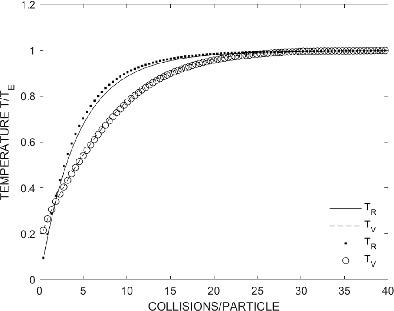当前位置:
X-MOL 学术
›
Int. J. Numer. Methods Fluids
›
论文详情
Our official English website, www.x-mol.net, welcomes your
feedback! (Note: you will need to create a separate account there.)
Rotation-translation collision model for DSMC with restricted energy exchange
International Journal for Numerical Methods in Fluids ( IF 1.7 ) Pub Date : 2021-07-13 , DOI: 10.1002/fld.5032 M. N. Macrossan 1
International Journal for Numerical Methods in Fluids ( IF 1.7 ) Pub Date : 2021-07-13 , DOI: 10.1002/fld.5032 M. N. Macrossan 1
Affiliation

|
In the standard implementation of Borgnakke–Larsen (BL) rotation and translation energy exchange in DSMC not every rotational mode of each molecule is active in every collision. In some collisions, the rotation mode of one molecule is “frozen” (cannot be changed by the collision); in other collisions the rotation mode of both molecules is frozen. Different relaxation rates are obtained by varying the proportion of frozen-rotation collisions. In 1974 Larsen and Borgnakke proposed a “restricted exchange” version of BL in which a portion of the energy of each mode is frozen in each collision; the method seemed physically plausible but did not satisfy the detailed balance condition. In 1978 Pullin proposed a general restricted exchange of BL exchange which did satisfy the detailed balance condition; it was more CPU intensive than the original BL scheme. It was seen as “laborius” and “cumbersome” and it seemed to be incompatible with vibration energy-exchange models. Here a simplified version, a special case, of Pullin's restricted exchange scheme is described. The new method is only 12%–17% more CPU-intensive than standard BL methods and can be used with the standard DSMC quantum vibration exchange model. It is shown that the elimination of frozen-rotation collisions changes the high energy distribution of vibration energy in nonequilibrium conditions which may slightly decrease the nonequilibrium dissociation rate when restricted exchange is used with the quantum-kinetic method for dissociation reactions.
中文翻译:

能量交换受限的 DSMC 旋转平移碰撞模型
在 DSMC 中 Borgnakke-Larsen (BL) 旋转和平移能量交换的标准实现中,并不是每个分子的每个旋转模式在每次碰撞中都是活跃的。在某些碰撞中,一个分子的旋转方式是“冻结”的(不能被碰撞改变);在其他碰撞中,两个分子的旋转模式被冻结。通过改变冻结旋转碰撞的比例获得不同的弛豫率。1974 年,Larsen 和 Borgnakke 提出了 BL 的“受限交换”版本,其中每个模式的一部分能量在每次碰撞中都被冻结;该方法在物理上似乎是合理的,但不满足详细平衡条件。1978年,普林提出了满足详细平衡条件的BL交易所的一般限制性交易所;它比原始 BL 方案更占用 CPU。它被视为“费力”和“繁琐”,似乎与振动能量交换模型不兼容。这里描述了普林受限交换方案的一个简化版本,一个特例。新方法仅比标准 BL 方法多占用 12% 到 17% 的 CPU,并且可以与标准 DSMC 量子振动交换模型一起使用。结果表明,当限制交换与量子动力学方法用于解离反应时,冻结旋转碰撞的消除改变了非平衡条件下振动能的高能量分布,这可能会略微降低非平衡解离率。这里描述了普林受限交换方案的一个简化版本,一个特例。新方法仅比标准 BL 方法多占用 12% 到 17% 的 CPU,并且可以与标准 DSMC 量子振动交换模型一起使用。结果表明,当限制交换与量子动力学方法用于解离反应时,冻结旋转碰撞的消除改变了非平衡条件下振动能的高能量分布,这可能会略微降低非平衡解离率。这里描述了普林受限交换方案的一个简化版本,一个特例。新方法仅比标准 BL 方法多占用 12% 到 17% 的 CPU,并且可以与标准 DSMC 量子振动交换模型一起使用。结果表明,当限制交换与量子动力学方法用于解离反应时,冻结旋转碰撞的消除改变了非平衡条件下振动能的高能量分布,这可能会略微降低非平衡解离率。
更新日期:2021-07-13
中文翻译:

能量交换受限的 DSMC 旋转平移碰撞模型
在 DSMC 中 Borgnakke-Larsen (BL) 旋转和平移能量交换的标准实现中,并不是每个分子的每个旋转模式在每次碰撞中都是活跃的。在某些碰撞中,一个分子的旋转方式是“冻结”的(不能被碰撞改变);在其他碰撞中,两个分子的旋转模式被冻结。通过改变冻结旋转碰撞的比例获得不同的弛豫率。1974 年,Larsen 和 Borgnakke 提出了 BL 的“受限交换”版本,其中每个模式的一部分能量在每次碰撞中都被冻结;该方法在物理上似乎是合理的,但不满足详细平衡条件。1978年,普林提出了满足详细平衡条件的BL交易所的一般限制性交易所;它比原始 BL 方案更占用 CPU。它被视为“费力”和“繁琐”,似乎与振动能量交换模型不兼容。这里描述了普林受限交换方案的一个简化版本,一个特例。新方法仅比标准 BL 方法多占用 12% 到 17% 的 CPU,并且可以与标准 DSMC 量子振动交换模型一起使用。结果表明,当限制交换与量子动力学方法用于解离反应时,冻结旋转碰撞的消除改变了非平衡条件下振动能的高能量分布,这可能会略微降低非平衡解离率。这里描述了普林受限交换方案的一个简化版本,一个特例。新方法仅比标准 BL 方法多占用 12% 到 17% 的 CPU,并且可以与标准 DSMC 量子振动交换模型一起使用。结果表明,当限制交换与量子动力学方法用于解离反应时,冻结旋转碰撞的消除改变了非平衡条件下振动能的高能量分布,这可能会略微降低非平衡解离率。这里描述了普林受限交换方案的一个简化版本,一个特例。新方法仅比标准 BL 方法多占用 12% 到 17% 的 CPU,并且可以与标准 DSMC 量子振动交换模型一起使用。结果表明,当限制交换与量子动力学方法用于解离反应时,冻结旋转碰撞的消除改变了非平衡条件下振动能的高能量分布,这可能会略微降低非平衡解离率。











































 京公网安备 11010802027423号
京公网安备 11010802027423号